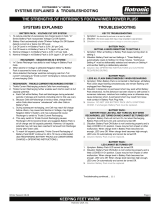
Contents:
1 Introduction ................................................................................................................... 32
1.1 The essential performance features of the ALC 8500-2 Expert .................................... 32
1.2 Proper use ..................................................................................................................... 34
2 Safety Notes .................................................................................................................. 34
3 Controls, display elements ............................................................................................ 36
4 Charge processes, charge outputs ............................................................................... 37
5 Battery capacities, charge power, currents ................................................................... 38
6 Battery Ri measurement function ................................................................................. 38
7 Lead-acid activator (reviver) function ............................................................................ 40
8 Data logger .................................................................................................................... 41
9 USB interface ................................................................................................................ 41
10 The charger in use ......................................................................................................... 41
10.1 Basic settings ................................................................................................................ 41
10.2 Main window ................................................................................................................. 41
10.3 Channel windows .......................................................................................................... 43
10.4 Channel LEDs ............................................................................................................... 43
11 Main Menu .................................................................................................................... 44
12 Selecting the charge channel, entering data ................................................................. 44
12.1 Channel menu ............................................................................................................... 44
12.2 Battery ........................................................................................................................... 44
12.3 Conf. Bat. (configuring batteries) .................................................................................. 45
12.3.1 Charge rates .................................................................................................................. 46
12.4 Function ........................................................................................................................ 47
12.4.1 Charge ........................................................................................................................... 47
12.4.2 Discharge ...................................................................................................................... 47
12.4.3 Discharge / Charge ....................................................................................................... 47
12.4.4 Test ................................................................................................................................ 47
12.4.5 Refresh .......................................................................................................................... 48
12.4.6 Cycle ............................................................................................................................. 48
12.4.7 Forming (balancing) ....................................................................................................... 48
12.4.8 Maintain ......................................................................................................................... 48
13 B. Resist. (battery Ri measurement function) ................................................................ 49
14 Conf. menu .................................................................................................................... 51
14.1 Database ....................................................................................................................... 51
14.1.1 New Bat. ....................................................................................................................... 51
14.1.2 Edit Bat. ........................................................................................................................ 51
14.1.3 Del. Bat. ........................................................................................................................ 52
14.1.4 Return ........................................................................................................................... 52
14.2 Charge / discharge parameters .................................................................................... 52
14.3 Setup ALC ..................................................................................................................... 53
14.3.1 Illuminat. ........................................................................................................................ 53
14.3.2 Contrast ........................................................................................................................ 53
14.3.3 Al. beep ......................................................................................................................... 53
14.3.4 But. beep ....................................................................................................................... 53
15 Display of charged-in / discharged capacity ................................................................ 54
16 Reading out the data logger on-screen ........................................................................ 54
17 Reading out the data logger via the USB interface ....................................................... 54
18 Supplementary notes .................................................................................................... 55
18.1 Reversed polarity protection ......................................................................................... 55
18.2
18.3 Automatic cooling fan ................................................................................................... 55
18.4 Output stage fuses ........................................................................................................ 55
18.5 Mains fuse ..................................................................................................................... 55
18.6 Temperature sensor ...................................................................................................... 55
18.7 Error messages ............................................................................................................. 56
19 Maintenance, care ......................................................................................................... 57
20 Specification ................................................................................................................. 58
GB
Discharging single cells ................................................................................................. 55
31























